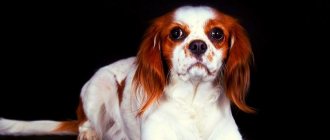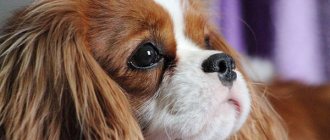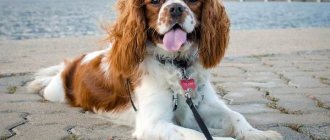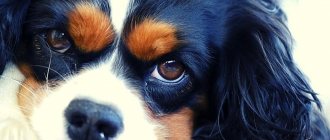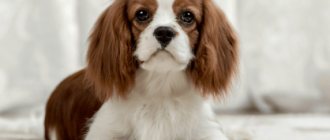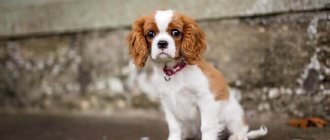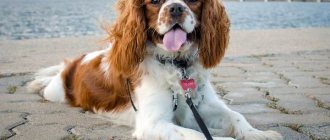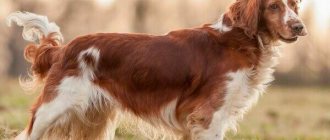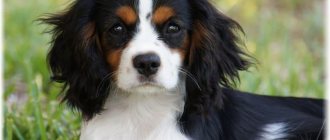Spaniels are the name of a large group of breeds, which includes both hunting and decorative and even dwarf dogs.
These include breeds such as Cocker Spaniel, Russian Spaniel, Continental Toy Spaniel and others
Cavalier King Charles spaniels, which will be discussed in the article, are small decorative dogs, ideal for keeping even in small city apartments.
Possessing an easy-going character and a balanced psyche, they get along well with children and grow up to be faithful companions.
But representatives of this breed also have some disadvantages and features that you should know about in advance.
Origin story and what it looks like in the photo
Charles II, King of Scotland, reigning in the 17th century, was very fond of dogs. It was thanks to him that King Charles Spaniels were bred, which were especially popular in Europe in the 15th-17th centuries.
It was these dogs that became the ancestors of the Cavalier King Charles Spaniels, bred in Great Britain in the late 18th and early 19th centuries, when the reign passed to William III of Orange.
The new king preferred pugs, so representatives of the bourgeoisie were forced to abandon spaniels.
However, many people did not like pugs, so breeding work began to change the King Charles, which resulted in the appearance of new dogs with a short muzzle, miniature size and small paws.
The breed was named after the English royalists - the Cavaliers.
Unlike their ancestors, who were not only decorative dogs, but also used for hunting, Cavalier Charles King Spaniels are exclusively domestic dogs, unsuitable for working dogs.
The development of the Cavaliers led to the almost complete disappearance of the King Charles, but through the efforts of the American R. Eldridge, the breed was restored at the beginning of the 20th century.
Representatives of both breeds were called King Charles until 1945, after which the dogs were officially divided into 2 separate breeds . Cavaliers received official recognition from the FCI in 1955.
Interesting Facts
- Representatives of this breed are considered healing dogs. Many of them are kept at hospitals to reassure patients.
- In America there lives a dog named Duke, famous for his ability to heal people. He helps fire survivors undergo rehabilitation.
- Fans of this breed include Ronald Reagan, Johnny Depp, Frank Sinatra, Tary Hatcher, Natalie Wood and Hugh Hefner.
Description and standard
Cavalier Charles King Spaniels are petite, graceful and sweet-looking dogs that move freely and elegantly and are intended for indoor use only.
In accordance with the official breed standard for representatives of this breed:
- almost flat skull between the ears;
- a wedge-shaped muzzle, the length of which from the base of the shallow stop to the tip of the nose is about 3.8 cm;
- scissor bite;
- the eyes are large, round in shape, not bulging, the iris is dark;
- the ears are long, hanging, set high, abundantly covered with long, decorative hair;
- neck of medium length, slightly curved;
- the back is straight, the loin is short;
- chest of moderate depth, ribs well sprung;
- The limbs are straight, with moderate bones, the shoulders are sloping, the elbows fit tightly to the chest, the knee joints are well defined.
The coat is long, silky, slight waviness is acceptable, but not curly.
Character traits
Representatives of this breed are distinguished by their easy-going and easy-going disposition, loyalty and friendliness.
These are sociable dogs that need communication - they strive to participate in the life of the family and cannot allow anything to happen in the house without their participation.
Sometimes they can be too annoying, so it’s better if several people live in the house - this will help the pet always find company for itself and not be too annoying for one person.
These dogs are absolutely not characterized by anger or aggressive behavior. This is precisely what prevents them from being used as watchmen. For gentlemen, any stranger is, first of all, a potential friend.
At the same time, they are very brave and, if one of the family members is in danger, they are ready to defend him without hesitation, even if the enemy is much larger.
Any shortcomings in the character and behavior of representatives of this breed can be corrected by proper upbringing..
Cavalier King Charles Spaniels are inquisitive and active dogs and need long, vigorous walks at least twice a day.
These dogs should not be left alone - out of boredom and melancholy, gentlemen can chew the furniture, after which, having received a scolding from the owner, they will worry about what they have done for a long time.
Regular repetition of such situations leads to the fact that the pet lives in constant stress, which has a negative impact not only on its character and health.
Expert opinion
Kozhevin Semyon Kirillovich
Expert dog handler.
Cavalier King Charles Spaniels are very docile and affectionate dogs. As a rule, their shortcomings are due to mistakes made during upbringing, or its complete absence. It sometimes happens that these dogs behave aggressively even with proper upbringing; most often this is caused by incorrect, probably closely related matings, which negatively affect the psyche of the animals. But such situations are rare and can be avoided by purchasing a puppy from specialized nurseries.
Characteristics of Cavalier King Charles Spaniels
Cavalier King Charles Spaniels are classified as English Toy Spaniels. They come from hunting dogs and were previously used to hunt birds. In the Middle Ages, due to their attractive appearance, these miniature spaniels were bred as decorative pets.
Representatives of the breed can become a devoted companion to any owner: a child, an old man, a lonely young man. This is an ideal family dog who loves children. Due to their flexible nature, intelligence and cheerfulness, they are used in canistherapy. In the UK, they believe that representatives of this breed help cope with stress, lift their spirits, and make it easier for children with special needs to establish contact with the outside world.
| Options | Characteristic |
| breed name | Cavalier King Charles Spaniel |
| a country | Great Britain |
| breed group | decorative and companion dogs, toy spaniel section |
| application | companion |
| life expectancy | 11-12 years old |
| height | up to 32 cm |
| weight | 5.5-8 kg |
| wool | long, silky |
| color | ruby, tricolor, any combination of red and white |
| aggression | No |
| activity | high |
| intelligence | smart, easy to train |
| difficulty of care | average, moderate shedding, but show dogs require special grooming |
pros
These charming dogs with beautiful fur and expressive eyes are very smart, affectionate, and sociable. They are obedient and not prone to dominance. Therefore, the breed is suitable for inexperienced dog breeders. These spaniels can lift your spirits; communicating with them helps relieve stress. They have several more advantages:
- they are always in a good mood, they are cheerful and playful;
- there is no aggression;
- peaceful, gets along with any pets and other dogs;
- friendly and welcoming to everyone;
- love children, are patient, can be nannies;
- affectionate, love touch;
- do not need long walks;
- wool does not smell, hypoallergenic;
- Thanks to their small size, they live quietly even in a small apartment.
Minuses
This is a family dog, companion, decorative pet. It is recommended to start it only for this purpose. She cannot become a watchman; her hunting skills are also almost lost. But she is active, playful, and requires a lot of attention. Therefore, the breed is not suitable for homebodies and unsociable people. These dogs have a few more disadvantages that can create problems:
- They do not tolerate loneliness well, out of boredom they make a mess at home and chew things;
- difficult to care for the coat;
- can be emotional, playful, annoying;
- friendly to strangers;
- bark a lot and loudly;
- have poor health and are prone to allergies.
The video complements the characteristics of the breed:
Video: Cavalier King Charles Spaniel - all about the dog breed
Video: Cure for stress - Cavalier King Charles Spaniel
Video: Cavalier King Charles Spaniel. Pros and cons of the breed
Advantages and disadvantages
Despite the fact that these dogs have an attractive appearance, a gentle character and are devoid of aggression, it is wrong to think that they are suitable for everyone without exception..
You should make your final decision about buying a pet after familiarizing yourself with all the advantages and disadvantages of the breed.
pros:
- devotion;
- agreeableness;
- lack of tendency to dominate;
- goodwill;
- occasional barking;
- cleanliness;
- intelligence and intelligence;
- possibility of keeping even in a small apartment;
- ability to get along with children and pets.
Minuses:
- need for constant attention;
- intolerance of loneliness;
- hyperactivity;
- need for regular long walks;
- a tendency to many hereditary diseases.
In addition, representatives of this breed are not suitable for use as watchmen and security guards.
List of suitable nicknames
To name a good-natured puppy that appears in the house, but with natural hunting inclinations, you need to look through different options. The royal status of the pet is also taken into account.
When looking for a name for a dog, they often turn to the English sound, keeping in mind the origin of the breed: Albion, Byron, King, Sherlock. Appearance may play a role, giving the following nicknames: Orange, Sunset, Mango, Ruby. Often the source of inspiration is the names of heroes of various works: Ivanhoe, Barrymore, Hamlet, Gray, Greene, Duncan, Zorro.
Females are also called based on their appearance, character and origin: Amalia, Arabella, Bastinda, Becky, Gloxinia, Gloria, Daisy, Dolly, Camellia, Camilla, Coney, Lizzie, Magnolia, Misty, Nancy, Stephanie, Alice, Ellie,
Difference from spaniel
The division of Cavaliers and Charles Kings into 2 independent breeds is not accidental - there are a number of differences between these dogs:
- Cavaliers have a rather long nose, while Charles Kings are more snub-nosed;
- the Charles Kings have a dome-shaped skull, while the Cavaliers have almost flat skulls;
- According to the standard, cavaliers have a scissor bite, while kings have an undershot bite.
In addition, Cavaliers are slightly larger than Charles Kings, but they cannot be used for work.
Color variations
The breed standard strictly regulates the possible coat colors of Cavalier Charles King Spaniels and allows only four color options.
Blenheim
The most common color . On the main white-pink (pearl) color there are spots of red-brown shades.
In the drawing of the classic version, the ears and cheeks are painted red; the spots on the body can be of any shape, but symmetry is desirable.
There should be 2 adjacent triangular shaped marks on the head, resembling an hourglass . It is acceptable to have a Blenheim mark on the forehead - a small red spot.
Ruby
The coat is a solid deep red color, the presence of white or black hairs is unacceptable. The skin is pigmented black.
Tricolor
The main color of the coat is pearl, rather large black spots affect the body, ears and forehead. There should be a white mark on the head that goes down to the muzzle and lips, and red marks above the eyes and on the cheeks.
A small amount of red hair on the forearms is acceptable.
Black
The coat is deep black with reddish tan on the eye sockets, cheeks, ears, chest, paws and groin area. White color is not acceptable. The nose, eyelids, outer lip line and paw pads are pigmented black.
Varieties
There is a conditional division of the breed. The criterion is the predominant coat color:
| Type | Peculiarities |
| Black and tan - King Charles color | The main background has an anthracite tint. The red spots on the chest, cheeks, tail and above the eyes along the perimeter are clearly defined. White marks are excluded |
| Ruby | Presented with a solid dark red pigment |
| Tricolor - the color of Prince Charles's dog | White and black combination with tan marks predominates |
| Blenheim color | Symmetrical chestnut spots are prominent. A distinctive feature is a light mark on the forehead with a diamond configuration. Pearly white background dominates |
Is he good with children and does he get along with other pets?
Cavalier Charles King Spaniels are friendly and affectionate dogs, which, combined with their activity and curiosity, makes them ideal pets for families with small children..
They get along well with kids and can spend a lot of time playing with them.
IMPORTANT!
Gentlemen will never offend children; on the contrary, they are always ready to protect them.
Representatives of this breed do not strive for leadership and dominance, so they easily find a common language with other pets, be they dogs, cats or rodents.
Training
The Cavalier King Spaniel dog breed has high intelligence and is very easy to learn any commands. However, they quickly get bored with the learning process itself, so at the end of the lesson they can pretend that they don’t understand anything. It’s simply better to stop the lesson here and continue the next day. There is no need to overload the dog, otherwise it will get bored. Classes should be conducted in a playful way.
IMPORTANT! Under no circumstances should you raise your voice at gentlemen, otherwise they may never agree to engage again.
But you can stock up on treats to encourage these dogs before training.
Feedback from owners about the training process: Make the training process positive. Be sure to reinforce your puppy's desire to exercise with his favorite treats. Be sure to praise your pet!
Care and maintenance
Caring for these dogs is not difficult, the main thing is to carry out all hygiene procedures regularly . This will help not only maintain the external attractiveness of your pet, but also maintain its health.
Wool and bathing
The coat of cavaliers has a silky structure and is not prone to the formation of tangles, so these dogs can be combed once every 3-5 days, with the exception of molting periods, when this must be done daily.
Representatives of this breed do not need to be cut or trimmed.
It is necessary to wash your pet's paws after every walk, and give him a full bath using a special shampoo and conditioner no more than 2 times a month so that the coat retains its natural structure.
After washing, the wool should be blotted with a terry towel and dried with a hairdryer..
Ears
A lot of dirt and wax accumulate in the ears of these dogs, so they need to be cleaned weekly using cotton swabs and wet wipes soaked in a special lotion.
This must be done carefully so as not to hurt the eardrum..
Eyes
Eyes should be wiped daily with clean cotton pads or lint-free wipes soaked in warm boiled water, chamomile infusion, tea leaves or a special product.
Teeth
To minimize the likelihood of plaque and tartar formation, your pet’s teeth should be brushed 1-2 times a week with a special brush and toothpaste for dogs.
Also, your dog’s diet should include fresh tomatoes and treats that promote mechanical cleaning of the teeth..
Claws
Trim the nails with a guillotine nail clipper every 3-4 weeks, smooth the sharp edges with a nail file to avoid cracking.
Life expectancy, health and major diseases
The lifespan of Cavalier King Charles Spaniels depends on genetics, housing conditions and quality of care.
On average, these dogs live 9-15 years.
Representatives of this breed have a fairly strong immune system, but long-term selection, linear breeding and a limited genetic base have made them prone to many hereditary pathologies and organ defects.
Most often they are diagnosed:
- myxomatous valve degeneration;
- syringomyelia;
- syndromes of episodic falling, dry eye, hanging tongue and curly coat;
- ophthalmological diseases - glaucoma, entropion, cataract, retinal dysplasia, entropion, conjunctivitis;
- patellar instability;
- obesity;
- allergies;
- diabetes;
- congenital and acquired hernias;
- flycatching;
- Legg-Calvé-Perthes disease;
- arthrosis;
- inflammation of the paraanal glands;
- arthritis;
- epilepsy;
- hydrocephalus;
- cryptorchidism;
- prolapse of the knee joint;
- endocarditis;
- soft sky;
- otitis.
CAREFULLY!
In addition, these dogs are susceptible to infections, and bitches often experience false pregnancies.
Nutritional Features
Representatives of this breed are unpretentious in food; they can be fed both natural products and industrial feeds..
The main advantage of natural feeding is that all nutrients are of natural origin and are better absorbed by the pet’s body.
However, it is impossible to create a balanced diet without the help of a veterinarian and without having certain knowledge of veterinary nutrition.
With this type of nutrition, the pet’s menu needs to include:
- lean meat;
- offal;
- rice, buckwheat, oatmeal;
- seasonal vegetables and fruits;
- boiled sea fish;
- eggs;
- dairy products.
It is forbidden to give these dogs:
- potato;
- melons, pears, citrus fruits;
- pork;
- butter;
- bones;
- sweets, baked goods;
- pickles, marinades;
- smoked meats and sausages;
- spicy, fried foods.
It is also useful to include flax seeds in the menu - they have a beneficial effect on the condition of the coat. In addition, with such a diet, the pet must be given additional vitamins and minerals.
Industrial feeds are convenient because they are easy to dose and use, and their use does not require additional intake of vitamin and mineral complexes, since the composition is already enriched with all necessary macro- and microelements.
These dogs are suitable only for high-quality premium, super-premium or holistic food. It is also necessary to ensure that the food is appropriate for the age, health and physiological state of the pet.
The most suitable diets are manufactured by the trademarks Go, Probalance, Savarra, Royal Canin, Pro Plan, Acana.
You should not mix both types of food - this negatively affects the digestion of dogs.
Menu for the week
| Day of the week | Menu |
| Monday | 300 g beef, 50 g greens, 100 g oatmeal, 100 g yogurt, 150 g vegetables |
| Tuesday | 300 g boiled fish, 100 ml natural yogurt, 100 g vegetables, 50 g cottage cheese, 150 g buckwheat porridge |
| Wednesday | 100 ml kefir, 50 g herbs, 350 g offal, 100 g cottage cheese and 100 g vegetables |
| Thursday | 120 g cottage cheese, 30 g greens, 1 egg, 250 g beef, 200 g vegetables, 100 g rice porridge |
| Friday | 100 ml kefir, 50 g herbs, 350 g offal, 100 g cottage cheese, 100 g vegetables |
| Saturday | 250 g of boiled sea fish, 100 ml of natural yogurt, 100 g of vegetables, 100 g of cottage cheese and 150 g of buckwheat porridge |
| Sunday | 250 g beef, 50 g greens, 100 g oatmeal, 100 g cottage cheese, 200 g vegetables |
How to train correctly?
Cavalier Charles King Spaniels are intelligent and quick-witted dogs that are easy to train. Training is also simplified by the lack of stubbornness in these dogs, as well as their desire to please the owner.
It is important to choose the right training method . Representatives of this breed should not be yelled at or physically punished. They learn best through play and proper encouragement with praise or treats.
These are decorative dogs and do not require serious training.
NOTE!
It is enough to take a general obedience course from a professional dog handler, thanks to which the dog will acquire the skills of correct behavior on the street and in the house, develop self-control and master such necessary commands as “no”, “come to me”, “near”, “sit”, “lie down”. ", "stand", "place", "ugh".
Exhibition animals should begin to be trained to stand at 4-5 months..
Personality of the Cavalier King Charles Spaniel
These are highly human-oriented dogs. They constantly need communication, attention from the owner, and affection. They love touching and stroking so much that they can be annoying, jumping on people, climbing on people's laps. They are very curious, try to participate in all activities, and accompany their owner everywhere. Able to adapt to the mood and character of the owner, suitable for people of any age.
These dogs are recommended for large families so that they get more attention. But it is an ideal companion for lonely elderly people, capable of lifting their spirits with its cheerful character. It is not recommended to own Cavalier King Charles for people who are often not at home. When alone, these pets suffer greatly; they can start acting out from boredom.
Representatives of this breed are characterized by the following character traits:
- good nature;
- curiosity;
- cheerfulness;
- sociability;
- devotion;
- agreeableness;
- playfulness;
- emotionality.
This spaniel will not make a watchman; he is completely devoid of aggression. He loves all people and treats strangers kindly and welcomingly. Despite its good sense of smell and ringing bark, this dog will not warn of the approach of strangers and will not protect its owner. He would rather be affectionate towards strangers and try to play. And if he feels danger, he will run away.
These dogs love children very much. They are patient with their pranks, hugs, and support any games. If a child behaves rudely or greatly bothers the pet, he will never snap, he will simply try to leave and hide. Gentlemen also treat any pets kindly. They live peacefully with cats, birds, and rodents. They will not fight for leadership and will not enter into conflicts with dogs. Only sometimes do hunting instincts appear - spaniels love to chase pigeons or cats on the street.
Education and training
These small dogs are smart, quick-witted, and easily learn commands and different tricks. Therefore, the breed is suitable for inexperienced dog owners; with the right attitude, even children can train them. But sometimes when trained, these dogs can seem stubborn or stupid. Suddenly, the dog may stop following familiar commands. This is not because of obstinacy, but because of boredom. For training to bring results, you need to take into account the character and temperament of your pet. Dog handlers give the following recommendations:
- despite the fact that this is a decorative dog, you need to start training it from an early age;
- classes should be short and varied so as not to overtire the baby;
- It is better to conduct training in the form of a game;
- you need to exercise regularly, and the requirements for the pet’s behavior should be the same for all family members;
- You need to communicate with the dog affectionately, give commands in a calm voice, many gentlemen are very timid, they can be scared by screaming and refuse to exercise;
- physical punishment should also not be used; dogs with whom the owners behave rudely become aggressive, cowardly, and inadequate;
- The best training method is encouragement in the form of treats or affection.
With this dog it is easy to learn the basic commands: “place”, “to me”, “lie down”, “near”, “fu”. The commands “no”, “stay”, “nearby” are very important. You can let them off the leash on the street only after the dog learns to respond to them the first time. Spaniels can chase a cat or bird and get lost. With the right approach, you can learn tricks with these dogs; some of them participate in agility and obedience competitions.
For show dogs, the "stay" command has a slightly different meaning. They need to be taught the correct exhibition stance. It is better to start at 4-5 months using treats. Then the pet will not be confused at the exhibition.
How to choose? Boy or girl?
First of all, you need to choose a nursery. You should not buy a puppy from a place where the dogs are kept in unsanitary conditions or appear unkempt or sick.
Before buying, you need to get to know the parents of the future pet, find out about their health and character - if the puppy’s parents are sick or aggressive, there is a high probability that the baby has inherited this.
The puppy should be good-natured, cheerful, active and curious. Lethargy, apathy, lack of interest in toys and people indicate deviations in physical or mental development.
In addition, the baby must have:
- slightly convex forehead;
- well developed nostrils;
- large dark eyes;
- scissor bite.
The gender of the puppy does not affect its character: both females and males are very affectionate, loyal and get along well with other animals and children.
Therefore, you should choose the gender of the dog based on how it will be used: for breeding it is better to buy a female, for a show career - a male.
Rules for choosing puppies
Expert opinion
Anna Abramenko
An avid dog lover. Experience in veterinary medicine since 2009.
Ask a Question
In order not to make a mistake and purchase a purebred dog, turn to reputable kennels. They will offer a baby at least three months old who has already completed all the necessary vaccinations.
Such puppies adapt more easily to new conditions. Documents confirming compliance with the standard and describing the pedigree must be attached.
During a visual examination, attention is paid to the absence of aggression or excessive cowardice. Check the condition of the ears and eyes, which should be clean. By tactile palpation of the tummy, the absence of bloating is determined, which may indicate problems with digestion.
Price range
The cost varies depending on the class of the puppy, its age, gender, as well as the presence of a pedigree and other documents.
Thus, a puppy with a veterinary passport and RKF metric costs on average 30-35 thousand rubles; for a puppy with all the documents and appearance that allows him to qualify for prizes in exhibitions and competitions, you need to pay at least 50 thousand rubles.
Prices for puppies born from champions or as a result of matings of a male and a female from different countries start from 65 thousand rubles.
Price
When planning a purchase, you should immediately think about the main purpose of having a dog in the house. This will allow you not to be disappointed in the future and get maximum pleasure from communicating with this faithful and intelligent individual.
The average cost of a puppy, which, due to its capabilities, will not be able to qualify for championship titles, but will become a beloved pet, is 45 thousand rubles.
If active exhibition activity is predicted, then options with a certain pedigree and the makings of future winners of different levels of competition will be offered. In this case, the puppy costs 85,000 rubles. and more.

